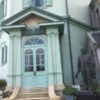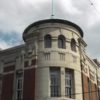網干区っていう町
姫路に網干区って所があって 初めて行ってみた。

■玄関

■外塀が立派です。

■看板

■床の大理石デザインがいい。

■洋間もいい。
旧山本家住宅
そんな中に”旧山本家住宅”がある。

■ステンドグラス

■なにこれって感じのステンドグラス。

■壁にアワビのようなものが埋め込まれてる。

■昔の洋風階段。
家の中身がすごい!
しかし、このころの洋風建築には必ず、

■日本間の室内灯がすごい。

■日本庭園、庭がすごい。
道順的には・・・。
大阪から姫路に行くまでの道順的には 車で行くなら

■全体的な地図で

■近づくとこんな・・・。

■近所に”旧水井家”なんかもある。

■旧水井家住宅はこんな感じ。
※ちなみに
この近辺の街並みを見て、その後は海岸べりの方に行くのがいいかな。

■googleビューでみた、街並み
この辺の街並みの面白いところは、
I went to Aboshi-ku, Himeji, “Old Yamamoto residence”. The residence of a wealthy man who made his fortune in the shipping industry.
A town called Aboshi Ward
There was a place called Aboshi Ward in Himeji, and I went there for the first time. There is a big industrial company like “Daisel” in the old townscape and along the coast, and I don’t know why he is prospering, but when I see “Daisel”, I feel that it is prospering. Overall it’s a nice town, isn’t it? Aboshi seems to have been a fishing town in the old days, and he seems to have prospered with seaweed farming, and he seems to have been a shipping wholesaler after that. There is a waterway in the city, and he goes out to sea along that route and carries goods to each region by ship. There are many fishing towns in various places that prospered with shipping in the early Meiji era, and I often see them. Aboshi is also such a city.
Former Yamamoto Residence
In such a place, there is the “Old Yamamoto Residence”. A blend of Japanese and Western styles, Mr. Yamamoto was also a well-known figure in Aboshi, making a fortune in the shipping business, and even served as president of Aboshi Bank and mayor of Aboshi. This building was built by Mr. It seems to be a building in the early Meiji period, but the exterior is amazing, but the inside is worth seeing. Stained glass, old fashioned electric lights, Western-style room. Japanese style is Japanese style, and the feeling of an old rich Japanese house is amazing. There are many Japanese-style rooms along the corridor. The hanging scroll looks expensive, and the transom is also splendid.
The inside of the house is amazing!
However, Western-style buildings in those days always had stained glass. Also, the round interior lights of the past, and the various types of electricity, I wonder if this is a special order. There are quite a few indoor lights that are quite different, and there are many that are quite nice. The chandeliers and interior lights, if released as retro products, would be quite expensive and would be appreciated. It’s completely different, and he is supported by the head of the family and has patterns and designs related to the house, and these look expensive. This Yamamoto family is also a cluster of such important cultural properties. It’s amazing, the old Kanemo…
Directionally…
As for the route from Osaka to Himeji, if you’re going by car, you’ll basically need to take the Sanyo Expressway, the Chugoku Expressway, or the bypass. but···. However, the Tarumizu interchange is quite difficult. On the way to Akashi Kaikyo Bridge and Shikoku, I almost made a mistake in the directions to the Sanyo Expressway. Sometimes I go to Awaji Island by mistake… It’s weird, but you have to be careful, so the easiest way is to wake up Tsukimiyama and let him go straight into the bypass. As for the bypass, if you go straight on the Hanshin Expressway, it will automatically enter the bypass, so it’s difficult because he’s running on the streets, so the cars are crowded. I think the Chugoku Expressway has the least number of cars, but it’s quite a distance to the coast and it’s difficult to get down, so I don’t think I’ll use it much, but I think it’s the Sanyo Expressway. . The car is just right and it’s close to getting off. I always get lost around here, but is it Sanyo Expressway rather than going through the bypass?
After looking at the streets around here, I think it would be nice to go to the coast. There is a factory like Daicel, and he thinks it’s really interesting to see the foreigner-like things inside the building. As Daicel advanced its technology, he brought in many foreign engineers to Japan, and he improved his skills. There is a Western-style building where foreigners lived at that time. It looks great. If you go to the sea from there, there are quite a few parks, and he said that when you come to Himeji, the sea is quite beautiful. I think I’ll give it to the sea breeze, so I’d recommend him.
The interesting thing about the streets around here is that there are no buildings at all like in the city. It feels like a real old Japanese town. Is it a townscape or a residential area? And then, out of nowhere, a fairly old rich man’s house pops up. That is the former Yamamoto family, but that is the interesting part. The construction of the house is a little different from the one in the neighborhood, or rather, it looks like a rich man. I think the townscape of Omihachiman was like that, a building that looks like a temple standing on a flat ground, and this is the old house of a rich man. It’s quite old-fashioned and deserted, so it’s a little more relaxing. I think that’s the good thing about him going to places like this leisurely… what do you think?



